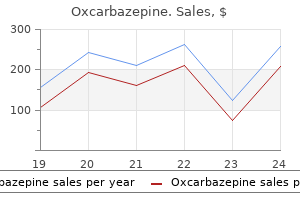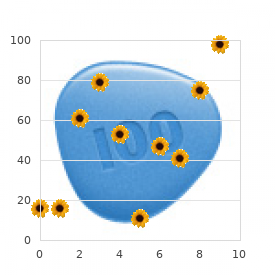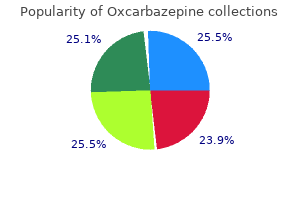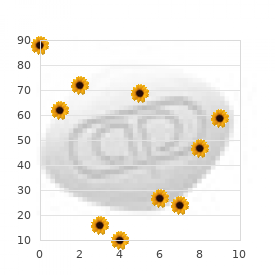Only $0.56 per item
Oxcarbazepine dosages: 600 mg, 300 mg, 150 mg
Oxcarbazepine packs: 30 pills, 60 pills, 90 pills, 120 pills, 180 pills, 270 pills, 360 pills
In stock: 542
8 of 10
Votes: 275 votes
Total customer reviews: 275
Description
Locating sensations from internal organs is less precise than from the skin because there are fewer afferent neurons in the internal organs and each has a larger receptive field symptoms type 1 diabetes 150 mg oxcarbazepine order with visa. Stimulus Intensity How do we distinguish a strong stimulus from a weak one when the information about both stimuli is relayed by action potentials that are all the same amplitude As the strength of a local stimulus increases, receptors on adjacent branches of an afferent neuron are activated, resulting in a summation of their local currents. In addition to increasing the firing frequency in a single afferent neuron, stronger stimuli usually affect a larger area and activate similar receptors on the endings of other afferent neurons. For example, when you touch a surface lightly with a finger, the area of skin in contact with the surface is small, and only the receptors in that skin area are stimulated. This "calling in" of receptors on additional afferent neurons is known as recruitment. However, more subtle mechanisms also exist that allow us to localize distinct stimuli within the receptive field of a single neuron. In some cases, receptive field overlap aids stimulus localization even though, intuitively, overlap would seem to "muddy" the image. Central nervous system Importance of Receptor Field Overlap An afferent neuron responds most vigorously to stimuli applied at the center of its receptive field because the receptor density-that is, the number of its receptor endings in a given area-is greatest there. The response decreases as the stimulus is moved toward the receptive field periphery. The firing frequency of the afferent neuron is also related to stimulus strength, however. Therefore, neither the intensity nor the location of the stimulus can be detected precisely with a single afferent neuron. The density of receptor terminals around area A is greater than around B, so the frequency of action potentials in response to a stimulus in area A will be greater than the response to a similar stimulus in B. The afferent neuron in the center (B) has a higher initial firing frequency than do the neurons on either side (A and C). The number of action potentials transmitted in the lateral pathways is further decreased by inhibitory inputs from inhibitory interneurons stimulated by the central neuron. Although the lateral afferent neurons (A and C) also exert inhibition on the central pathway, their lower initial firing frequency has a smaller inhibitory effect on the central pathway. Lateral inhibition can be demonstrated by pressing the tip of a pencil against your finger. Exact localization is possible because lateral inhibition removes the information from the peripheral regions. Lateral inhibition is utilized to the greatest degree in the pathways providing the most accurate localization. For example, lateral inhibition within the retina of the eye creates amazingly sharp visual acuity, and skin hair movements are also well-localized due to lateral inhibition between parallel pathways ascending to the brain. On the other hand, neuronal pathways carrying temperature and pain information do not have significant lateral inhibition, so we locate these stimuli relatively poorly. Once this location is known, the brain can interpret the firing frequency of neuron B to determine stimulus intensity.

Gamolenic Acid (Gamma Linolenic Acid). Oxcarbazepine.
- Nerve problems due to diabetes (diabetic neuropathy).
- Breast cancer, oral polyps, hyperlipidemia (high cholesterol and blood fat levels), heart disease, cancer prevention, attention deficit-hyperactivity disorder (ADHD), depression, chronic fatigue syndrome, hayfever, psoriasis, eczema, and other conditions.
- Are there safety concerns?
- High blood pressure.
- Dosing considerations for Gamma Linolenic Acid.
- How does Gamma Linolenic Acid work?
- Allergic skin conditions (eczema).
- Systemic sclerosis, a condition in which skin hardens.
- What other names is Gamma Linolenic Acid known by?
- Are there any interactions with medications?
Source: http://www.rxlist.com/script/main/art.asp?articlekey=96782
Muscles generate force and movements used to regulate the internal environment 911 treatment center 600 mg oxcarbazepine buy otc, and they also produce movements of the body in relation to the external environment. Three types of muscle tissue can be identified on the basis of structure, contractile properties, and control mechanisms-skeletal muscle, smooth muscle, and cardiac muscle. Most skeletal muscle, as the name implies, is attached to bone, and its contraction is responsible for supporting and moving the skeleton. As described in Chapter 6, contraction of skeletal muscle is initiated by action potentials in neurons of the somatic motor division of the peripheral nervous system and is usually under voluntary control. Sheets of smooth muscle surround various hollow organs and tubes, including the stomach, intestines, urinary bladder, uterus, blood vessels, and airways in the lungs. Contraction of smooth muscle may propel the luminal contents through the hollow organs, or it may regulate internal flow by changing the tube diameter. In addition, contraction of smooth muscle cells makes the hairs of the skin stand up and the pupil of the eye change diameter. It occurs autonomously in some cases, but frequently it occurs in response to signals from the autonomic nervous system, hormones, and autocrine or paracrine signals. Its contraction generates the pressure that propels blood through the circulatory system. Like smooth muscle, it is regulated by the autonomic nervous system, hormones, and autocrine or paracrine signals; it can also undergo spontaneous contractions. Several of the general principles of physiology described in Chapter 1 are demonstrated in this chapter. One of these principles, that structure is a determinant of-and has coevolved with-function, is apparent in the elaborate specialization of muscle cells and whole muscles that enable them to generate force and movement. The general principle of physiology that controlled exchange of materials occurs between compartments and across cellular membranes is exemplified by the movements of Ca21 that underlie the mechanism of activation and relaxation of muscle. The laws of chemistry and physics are fundamental to the molecular mechanism by which muscle cells convert chemical energy into force, and also to the mechanics governing bonemuscle lever systems. Finally, the transfer and balance of matter and energy are demonstrated by the ability of muscle cells to generate, store, and utilize energy via multiple metabolic pathways. This chapter will describe skeletal muscle first, followed by smooth and cardiac muscle. Cardiac muscle, which combines some of the properties of both skeletal and smooth muscle, will be described in more depth in Chapter 12 in association with its functions in the circulatory system. Each muscle fiber is formed during development by the fusion of a number of undifferentiated, mononucleated cells known as myoblasts into a single, cylindrical, multinucleated cell. Skeletal muscle differentiation is completed around the time of birth, and these differentiated fibers continue to increase in size from infancy to adulthood. Because cardiac muscle shares this characteristic striped pattern, these two types are both referred to as striated muscle. The third basic muscle type, smooth muscle, derives its name from the fact that it lacks this striated appearance.

Specifications/Details
The dominant follicle now starts to secrete enough estrogen that the plasma concentration of this steroid begins to increase 5 medications in pregnancy discount 150 mg oxcarbazepine visa. Estrogen, at these still relatively low concentrations, is exerting a negative feedback inhibition on the secretion of gonadotropins (Table 17. The stimulation of gonadotropin release by estrogen is a particularly important example of positive feedback in physiological control systems, and normal menstrual cycles and ovulation would not occur without it. The primary oocyte completes its first meiotic division and undergoes cytoplasmic changes that prepare the ovum for implantation should fertilization occur. The granulosa cells begin releasing progesterone and decreasing the release of estrogen, which accounts for the midcycle decrease in plasma estrogen concentration and the small rise in plasma progesterone concentration just before ovulation. Enzymes and prostaglandins, synthesized by the granulosa cells, break down the follicularovarian membranes. These weakened membranes rupture, allowing the oocyte and its surrounding granulosa cells to be carried out onto the surface of the ovary. The remaining granulosa cells of the ruptured follicle (along with the theca cells of that follicle) are transformed into the corpus luteum, which begins to release progesterone and estrogen. During its short life in the nonpregnant woman, the corpus luteum secretes large quantities of progesterone and estrogen 12, as well as inhibin. In the presence of estrogen, the high plasma concentration of progesterone causes a decrease in the secretion of the gonadotropins by the pituitary gland. Consequently, during the luteal phase of the cycle, plasma concentrations of the gonadotropins are very low 13. The corpus luteum has a finite life in the absence of an increase in gonadotropin secretion. With degeneration of the corpus luteum, plasma progesterone and estrogen concentrations decrease 15. This completes the description of the control of ovarian function during a typical menstrual cycle. When the corpus luteum degenerates, the decrease in hormone secretion allows the gonadotropin concentrations to increase enough to promote the growth of another group of follicles. This illustrates that ovarian events, via hormonal feedback, control the hypothalamus and anterior pituitary gland. Day 1 is the first day of menstrual flow, and the entire duration of menstruation is known as the menstrual phase (generally about 3 to 5 days in a typical 28-day cycle). During this time, the epithelial lining of the uterus-the endometrium-degenerates, resulting in the menstrual flow. The menstrual flow then ceases, and the endometrium begins to thicken as it regenerates under the influence of estrogen. This period of growth, the proliferative phase, lasts for the 10 days or so between cessation of menstruation and the occurrence of ovulation.
Syndromes
- Restlessness and difficulty sleeping
- Correct a birth defect or injury
- When was your last menstrual period?
- Seizures
- Voiding cystourethrogram
- Scarring inside your belly that could lead to a blockage in your bowel in the future
- Procainamide
- Stroke
- Convulsions

Moreover medications with codeine cheap oxcarbazepine 600 mg, the secreted digestive enzymes are themselves digested, and the resulting amino acids are absorbed into the blood. Finally, a critical component in the control of gastrointestinal functions is the role of the central nervous system. This completes our brief overview of some of the general functions of the organs of the digestive system. Because its major tasks are digestion and absorption, we begin our more detailed description with the mechanisms involved in these processes. The next section of the chapter will then describe, organ by organ, regulation of the secretions and motility that produce the optimal conditions for digestion and absorption. The common bile duct and the main pancreatic duct converge and empty their contents into the duodenum at the sphincter of Oddi. We describe here the major mechanisms for carbohydrate, protein, and fat digestion and absorption; nucleic acids are handled in similar general ways and are not discussed. Carbohydrate the average daily intake of carbohydrates is about 250 to 300 g per day in a typical American diet. About two-thirds of this carbohydrate is the plant polysaccharide starch, and most of the remainder consists of the disaccharides sucrose (table sugar) and lactose (milk sugar) (Table 15. Cellulose and certain other complex polysaccharides found in vegetable matter-referred to as dietary fiber (or simply fiber)-are not broken down by the enzymes in the small intestine and pass on to the large intestine, where they are partially metabolized by bacteria. The digestion of starch by salivary amylase begins in the mouth but accounts for only a small fraction of total starch digestion. It continues very briefly in the upper part of the stomach before gastric acid inactivates the amylase. The products of both salivary and pancreatic amylase are the disaccharide maltose and a mixture of short, branched chains of glucose molecules. These products, along with ingested sucrose and lactose, are broken down into monosaccharides-glucose, galactose, and fructose-by enzymes located on the apical membranes of the small-intestine epithelial cells (brush border). These monosaccharides are then transported across the intestinal epithelium into the blood. Most ingested carbohydrates are digested and absorbed within the first 20% of the small intestine. Starches (polysaccharides) and ingested small sugars (disaccharides) are metabolized to simple sugars (monosaccharides) by enzymes from the pancreas and on the apical membrane (brush border). Regardless of the source, most of the protein in the lumen is broken down into dipeptides, tripeptides, and amino acids, all of which are absorbed by the small intestine. Proteins are first partially broken down to peptide fragments in the stomach by the enzyme pepsin that is produced from an inactive precursor pepsinogen. Further breakdown is completed in the small intestine by the enzymes trypsin and chymotrypsin, the major proteases secreted by the pancreas. These last two enzymes split off amino acids from the carboxyl and amino ends of peptide fragments, respectively. At least 20 different peptidases are located on the apical membrane of the epithelial cells, with various specificities for the peptide bonds they attack.
Related Products
Additional information:
Usage: a.c.

Tags: buy 150 mg oxcarbazepine visa, 150 mg oxcarbazepine mastercard, buy 300 mg oxcarbazepine visa, purchase 600 mg oxcarbazepine
Customer Reviews
Sinikar, 30 years: Ions diffuse across membranes by passing through ion channels formed by integral membrane proteins. Normal body proteins may be altered by combination with drugs or environmental chemicals. During these early stages of neural development which occur during all trimesters of pregnancy and into infancy alcohol and other drugs, radiation, malnutrition, and viruses can exert effects that cause permanent damage to the developing fetal nervous system. The entire complex then forms a cagelike structure that leads to the aggregation of ligand-bound receptors into a localized region of membrane, forming a depression, or clathrin-coated pit, which then invaginates and pinches off to form a clathrincoated vesicle.
Gambal, 41 years: This decrease is partially offset by vasoconstriction of arterioles in other organs. If P is held constant in this example, flow through the tube decreases 16-fold because F 5 P/R. This is a classic example of the general principle of physiology that most physiological functions are controlled by multiple regulatory systems, often working in opposition. There are no valves at the entrances of the superior and inferior venae cavae (singular, vena cava) into the right atrium, and of the pulmonary veins into the left atrium.



